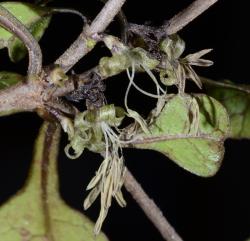- Taxon
- Gallery
Prostrate, evergreen, dioecious trailing shrub, with numerous spreading, long-trailing branches up to 10 m long and 10 mm diameter; these sometimes rooting at leaf nodes. Main stem usually solitary, sometimes two or more, prostrate; branches sparse to numerous, these arising at angles of 35- 45°; mature outer bark grey-brown to grey, sometimes mottled black, at first smooth, becoming deeply fissured and longitudinally cracked with age, persistent or shedding in small, irregular flakes; inner bark when exposed dark green. Juvenile shoots, slender, at first 4-angled, becoming terete with age, initially red-brown, later grey-brown to grey, finely fissured and/or longitudinally cracked; hairs short, eglandular, white, erect to antrorse bifarious. Leaves opposite, spathulate; seedling leaves of cultivated plants at first 2-4 × 4.5-6 mm, becoming larger with age; petioles 3-5 mm long, stout, winged; lamina rhomboid or deltoid, dark red-brown, often white mottled, or unifomly vinose above, paler beneath, apex acute often with sparse, minute, eglandular hairs, and/or apiculate, veins distinct, areolate. Adult leaves often clustered distally on short shoots, leaf internodes 0.2-0.3 mm (these usually obscured by stipules); petioles up to 23 mm long, stout, tapered toward base, winged; lamina 6-15 × 8-15 mm, flat, spreading, orbicular to broad oblong, coriaceous, ± glabrous, apex retuse to emarginate, occasionally obcordate, usually with a minute tuft of white hairs and apiculus; domatia 2-6 but often absent, 0.1-0.3 mm diameter, margins and interior cavity glabrous, often inhabited by small mites, usually forming deep, prominent swellings on the adaxial surface; lamina on exposed branches areolate, dull red-brown mottled dark green, yellow, or white with darker veins; lamina on shaded branches thinner textured, dark yellow-green, 13-27 × 16-27 mm. Internode stipules below apex of short shoots, 0.8-0.9 mm long, narrowly triangular, finely pubescent, with a single, dark central denticle, sheath 1/3 to ½ length of stipule, finely pubescent, marginal fringe chartaceous, dark greenish purple, finely ciliate. Plants unisexual; flowers apparently always axillary, located in axils of uppermost leaves of previous growth flush, solitary or paired. Male flowers larger and more numerous than female flowers. Pedicels 1.0-1.25 mm long, glabrous, dark violet to black-violet, each with a basal tubular connate bracteole; bracteoles c. 2 mm long, lobes linear, green, spotted purple, with white ciliate margins. Calyx reduced, dark violet to black-violet, often with a pale gland between the calyx lobes; lobes 4, lanceolate, basal portion dark purple, upper portion pale greenish-yellow, purple spotted, margins eglandular ciliate. Corolla 5-6 mm long; tube 1.5-2 mm long, elliptic, basal portion maroon, upper dark green streaked maroon; lobes 3-4, opening to half length of tube, lanceolate to ovate-acute, 3.5-4 × 1.4 mm, recurved, minutely papillose at apex and on inside. Filaments 6-9 mm long, cream, papillate. Anthers 2-4 , 2.4-3.5 × 0.8- 1.25 mm, oblong, dorsifixed, 2- locular, papillose at apex; pollen creamy yellow. Female flowers with pedicels similar to male flowers. Calyx much reduced, 4-lobed, adnate to ovary. Corolla tube 2.5-3 mm long obovoid, green-yellow, striped maroon in distil portion; corolla lobes 2-4 , opening to half length of tube, linear-lanceolate 2.5 × 0.6 mm, recurved, minutely papillose at apex and on the inside. Ovary ovoid, green, 2-locular. Stigmas 2, up to 6-7.5 mm long, terete, often twisted, papillose-pubescent; stigmatic hairs 0.1 mm long, white. Drupe narrowly ellipsoid topped by a persistent calyx, 5-9 × 2-4.5 mm, dull violet-black, mesocarp violet. Pyrenes (1-)2, unequal, when two, then the larger 7-7.5 × 2-3.5 mm, narrowly ovoid to ellipsoid, plano-convex, roughened on the inner face, operculum distinct, occupying c. ½ of pyrene surface. FL Jul-Oct; FR Jan.
[Reproduced from de Lange & Heenan (2001, New Zealand J. Bot. 39: 217-223) with permission from The Royal Society of New Zealand.]




